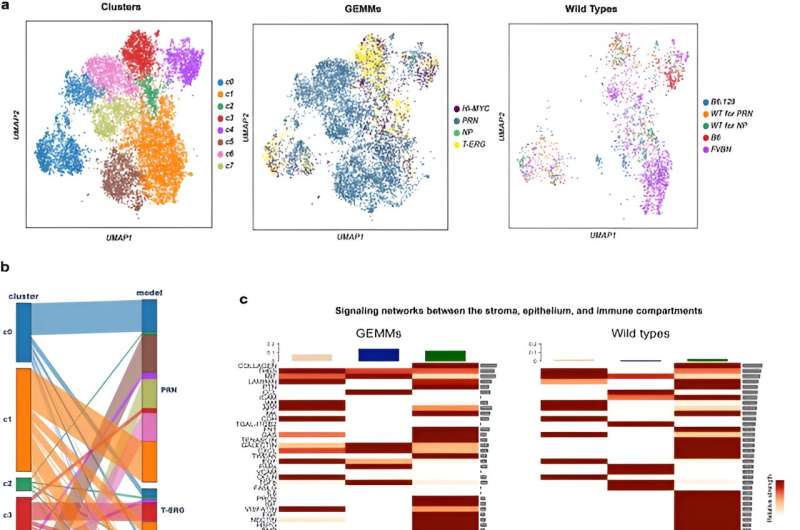This article has been reviewed according to Science X's editorial process and policies. Editors have highlighted the following attributes while ensuring the content's credibility:
fact-checked
peer-reviewed publication
trusted source
proofread
Stromal cells may help predict prostate cancer metastasis

Non-cancerous cells called stromal cells, which are found in and around prostate tumors, may be useful in assessing these tumors' potential to spread, and may even be targets for future prostate cancer treatments, according to a study led by researchers at Weill Cornell Medicine.
Stromal cells, found in all organs, contribute to wound healing, blood vessel formation and structural support for tissues. Scientists know that tumors often co-opt stromal cells to create a more supportive molecular environment for tumor growth and survival. But their precise roles in different cancers are only beginning to be delineated.
In the study, published Jan. 8 in Nature Communications, the researchers performed the most comprehensive analysis to date of stromal cells in and around prostate tumors. Examining prostate tumor mouse models as well as samples from human patients, they identified eight subpopulations of stromal cells with distinct tumor-associated patterns of gene activity. They found that certain changes in these patterns predicted tumor spread, or metastasis.
The researchers' analysis also uncovered signaling interactions among stromal cells, tumor cells and nearby immune cells that offer potential targets for preventing metastasis.
"These results illuminate the substantial impact of stromal cells on prostate cancer progression, and point to the possibility of new prognostic and therapeutic strategies," said study senior author Dr. Massimo Loda, chair of the Department of Pathology and Laboratory Medicine and the David D. Thompson Professor of Pathology at Weill Cornell Medicine and pathologist-in-chief at NewYork-Presbyterian/Weill Cornell Medical Center.
The study's co-first authors were Hubert Pakula, Mohamed Omar and Ryan Carelli, scientists working in the Department of Pathology and Laboratory Medicine at the time of the study. Omar is now an assistant professor of research in pathology and laboratory medicine.
Tumor progression is driven not just by the acquisition of new mutations in cancerous cells, but also by tumor-induced—and tumor-supporting—changes in non-cancerous cells.
To date, most of the research on these "tumor microenvironment" cells has focused on immune cells, which can be co-opted to suppress natural anti-cancer immunity and block the effects of cancer immunotherapies. But the tumor-supporting activities of stromal cells has also caught the attention of scientists. In 2017, for example, Loda's team discovered a gene activity signature in prostate cancer stromal cells that appears to encourage metastasis and may be useful in predicting the spread of tumor cells, which is the cause of most cancer mortality.
In the new study, the team followed up with a comprehensive analysis of stromal cells in prostate cancer, using mouse models representative of prostate tumors at different stages of progression and human prostate tumor samples.
Combining an advanced technique called single-cell RNA sequencing with AI-based analytical methods, the researchers identified eight major subpopulations of tumor-associated stromal cells—in both mouse and human tumors—based on their distinct patterns of gene activity when a tumor is present.
They showed that some of these tumor-associated patterns change when the cells acquire new cancer-driving mutations, and as tumors become metastatic. Strikingly, the researchers found that stromal cells surrounding prostate tumors often foster a molecular environment similar to bone, essentially preparing the tumor cells to spread to bones—a common site for prostate cancer metastasis.
The analysis yielded lists of signaling proteins and networks that become abnormally active or inactive during these changes. These signaling interactions between tumor cells, stromal cells and immune cells might be targets for future prostate cancer treatments to block metastasis, Loda noted.
In addition to looking for new therapeutic targets, Loda and his team hope to use their data and new experiments to develop prognostic tests on tumor-associated stromal cells that predict the aggressiveness of prostate tumors—which in turn could help physicians make better treatment choices.
"One could even imagine using such a test on biopsy samples where no tumor tissue is found," said Loda, who is also a member of Weill Cornell Medicine's Sandra and Edward Meyer Cancer Center. "If signs in the stromal cells point to the likely existence of a tumor, maybe an aggressive one, then perhaps you should biopsy again."
More information: Hubert Pakula et al, Distinct mesenchymal cell states mediate prostate cancer progression, Nature Communications (2024). DOI: 10.1038/s41467-023-44210-1




















